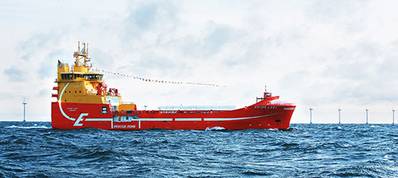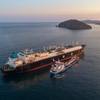OSV 'Test Lab' Targets Safety and Efficiency Gains
At the Greener Shipping Summit – Ships of the Future conference held in Athens yesterday, Dr. Nikolaos Kakalis, Head of DNV GL Strategic Research & Innovation in Greece, showed how the Viking Lady, an offshore supply vessel (OSV) in daily operation in the North Sea and full-scale test laboratory, could lead the way to improvements in the safety and efficiency of high-risk operations.
Dr. Kakalis presented the specific battery hybrid propulsion system and its benefits for Viking Lady to the Greek shipping community. These results stem from the FellowSHIP III research and development project between DNV GL, Eidesvik Offshore and Wärtsilä, co-funded by the Research Council of Norway.
DNV GL Research & Innovation in Norway and in Greece are working together with shipping companies and manufacturers to realize projects like FellowSHIP that advance the industry’s state of the art. “We went from idea generation through a fusion of innovative scientific approaches to technology development and full-scale testing in a structured and effective way,” said Dr. Kakalis.
The Viking Lady uses a conventional diesel-electric propulsion system, comprising four dual-fuel engines driving five thrusters for propulsion and maneuvering/dynamic positioning (DP). In this project, a lithium-ion battery with a capacity of 450 kWh was added – enabling the vessel to use hybrid-electric propulsion. The battery acts as an energy buffer that is able to cover the intense load variations that can occur, especially in DP and standby operations.
This effectively increases the propulsion system’s available power and redundancy – thereby increasing the level of safety in high-risk operations. This means that the gen-sets can operate with a relatively constant load and in an optimal way – making operations safer and more energy-efficient.
The battery hybrid installation has been tested in sea trials, which showed that a 15 percent reduction in fuel consumption, 25 percent reduction in NOx emissions and 30 percent reduction in GHG emissions can be realized in practice, especially for DP operations, DNV GL said. “Considering that the global fleet of offshore supply vessels of relevant sizes is over 4,000, such technologies have the potential to make an impact when it comes to improving sustainability,” Dr Kakalis noted.
COSSMOS, DNV GL’s in-house computer platform for modeling and simulating complex integrated ship machinery systems, played an important role in FellowSHIP III. COSSMOS provides an early-phase feasibility analysis, estimating the expected benefits in terms of energy efficiency, emissions and economics.
Dr. Kakalis explained how advanced simulations and optimization can direct the implementation of optimal power management strategies to arrive at maximum gains while ensuring the safety and operational capabilities of the vessel. “DNV GL invests 5 percent of its revenue in research and innovation every year, which is a reciprocal investment to our customers and the industry as a whole, through technology development and better services. In the FellowSHIP series of projects we have invested more than $2.5 million and we are glad to share such developments that improve safety and sustainability of our industry in practice,” Dr. Kakalis said.











